If you’ve ever had any job where you need to communicate with others online, chances are you’ve made some mistakes that led to unfortunate outcomes. You could have lost a client, made a boss very unhappy, or put yourself in an embarrassing situation.
As remote Filipino workers (RFWs), communicating effectively online is a skill that we all need to improve to avoid situations like these. It could even be what eventually leads us to earn a 6-digit salary through an online job.
Communicating well online is important for most remote jobs. These include jobs that need to communicate a lot, like working as a virtual assistant, and even jobs that don’t, like being a blog writer.
Listed below are 8 bad virtual communication examples so you can learn how to avoid making the same mistakes.
Table of Contents
Bad Virtual Communication Examples & What You Can Learn from Them
Example 1: Not Being Proactive in Your Communication
In the world of online jobs, you won’t go wrong by following the saying “Communicate early, often, and well”.
Because people are not proactive enough, this is one of the top bad virtual communication examples where remote Filipino workers often fail.
One common result of not being proactive is unmet expectations.
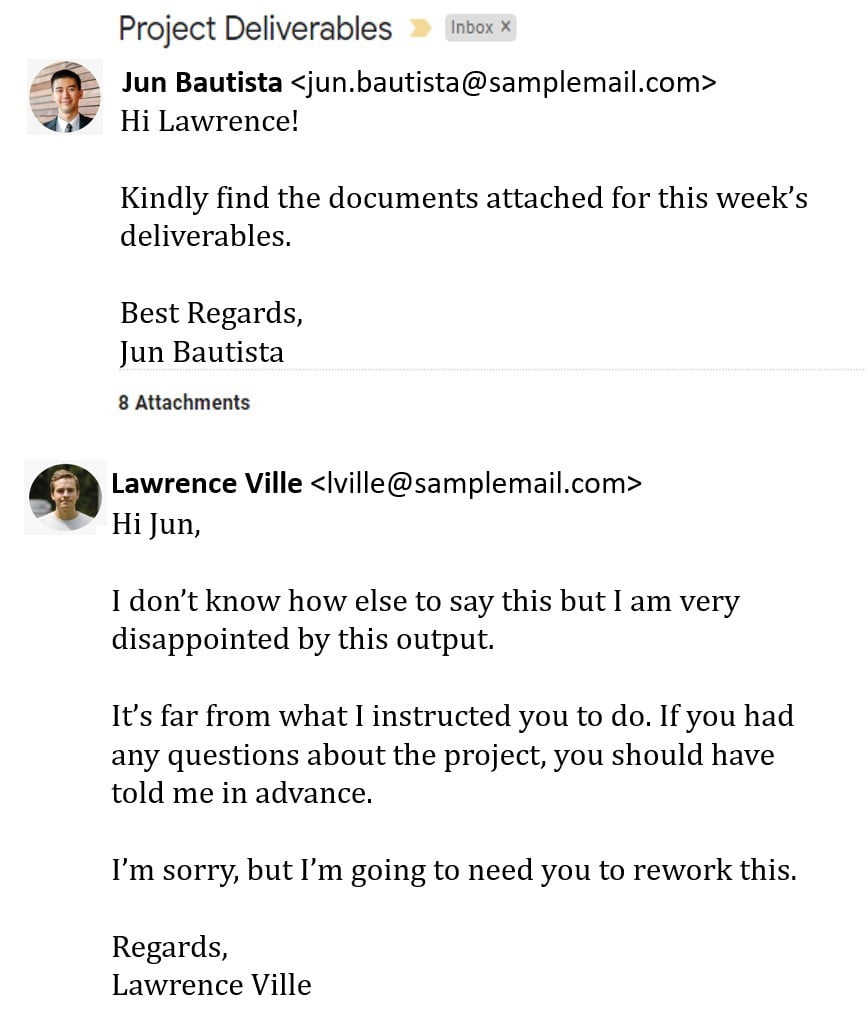
As you can see from the example above, the client was expecting another output entirely. This could have been avoided if the remote worker actively clarified all of the details of the project. You could do this by setting an alignment meeting with the employer or by having your client fill up a project brief document.
When you under-communicate, you often lack the information you need to do the job well. Some other unfortunate results of under communication include working more than is needed, unnecessary conflict, and losing clients.
Lesson: It’s better to overcommunicate, than to under-communicate. The client or employer will just tell you if they feel that it’s too much.
Example 2: Not Setting a Method to Communicate
Another virtual communication example of being proactive is by establishing the main ways you and your employer or client can contact each other. As RFWs, we work with people all over the world in different time zones.
So, it’s important to set ways that you can easily reach your employer or client whenever you need something from them. You also need to establish methods that they can contact you without fail.
This will help you avoid situations like the one below:
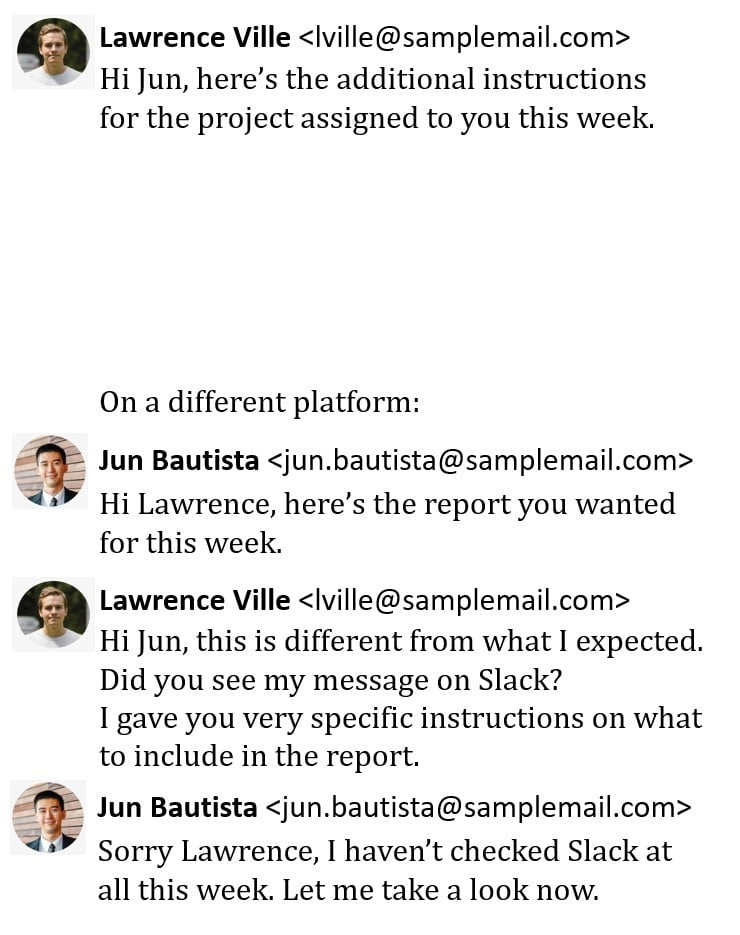
In this situation, you were not able to read the additional instructions from the client. So, there’s a higher chance that the output was not what the employer or client wanted.
Lesson: Set which virtual communication tools to use in advance. Whether it’s email, Skype, Telegram, or some other messaging app, make sure you and your employer or client are on the same page. The better the communication between you, the more likely that you will make a favorable impression.
You can also set regular meetings with your employer or client. This will ensure that both of your expectations are aligned with each other.
Example 3: Giving an Answer You Are Not Sure of
Sometimes when a client or boss asks us a question, we feel pressured to give an answer immediately even if we are not certain that the answer is correct. This is a very common bad virtual communication example.

In the example above, the remote Filipino worker immediately answered without checking the data. This resulted in a misunderstanding that could have been avoided very easily by taking the time to research.
In scenarios like this, misunderstandings are the least that could happen. You could get fired or negatively reviewed if the outcome of this mistake is severe.
Lesson: Take Time to Find the Correct Answer. Clients or bosses may want an answer immediately, however, they still prefer a correct answer than being misled by a wrong one. You can push back a bit, but they do want to feel that you are taking action to find the solution.
It’s okay to say “I need to check and get back to you as soon as I can.” This tells the person that you are on top of this task.
Example 4: Not Checking How the Client or Employer Prefers to Be Called
Early on in your work relationship, you should already ask your client or employer how they prefer to be called. It’s a bad virtual communication example where it gets more and more awkward to ask the longer you are working with the person.
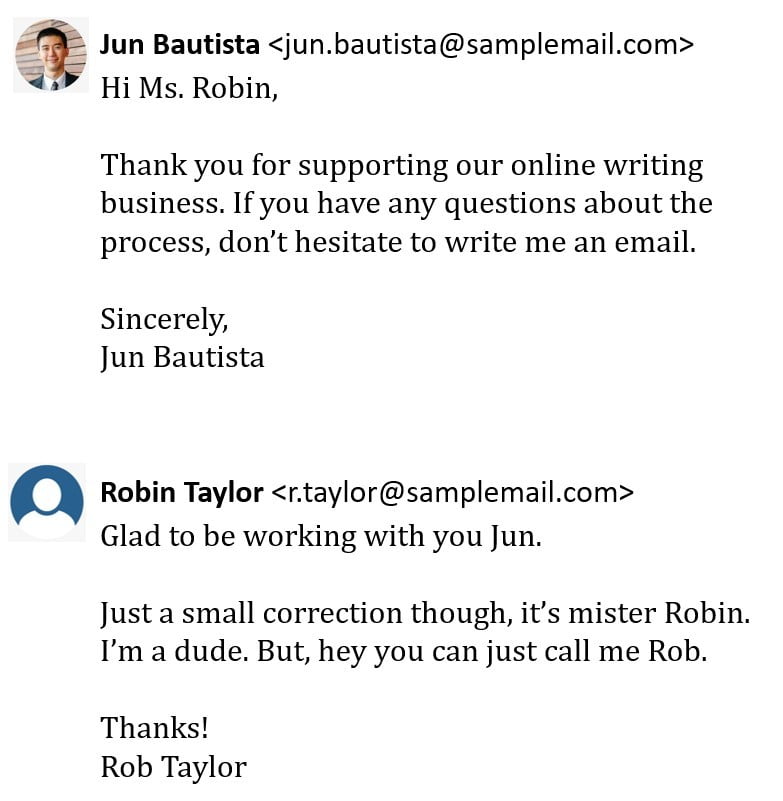
In remote work, a lot of conversations are just being done online. So, you can become prone to misconceptions like the example above. They’ve been working together for a while but they’ve put themselves in an embarrassing situation by not knowing the person’s gender.
Lesson: Ask Your Boss or Client How They Prefer to Be Called. This is even more important in countries where most people don’t like being called Sir or Ma’am. They may feel that those labels are too formal or distant when they prefer an informal or personal conversation.
Example 5: Not Pushing Back
It’s quite common among remote workers to just quietly accept a client or employer’s orders even if they already know that it is an impossible demand. Why? Because pushing back means having to negotiate or possibly enter into a conflict.
However, you should remember this: Sometimes the success of a project depends on you pushing back on the client or employer’s demands.
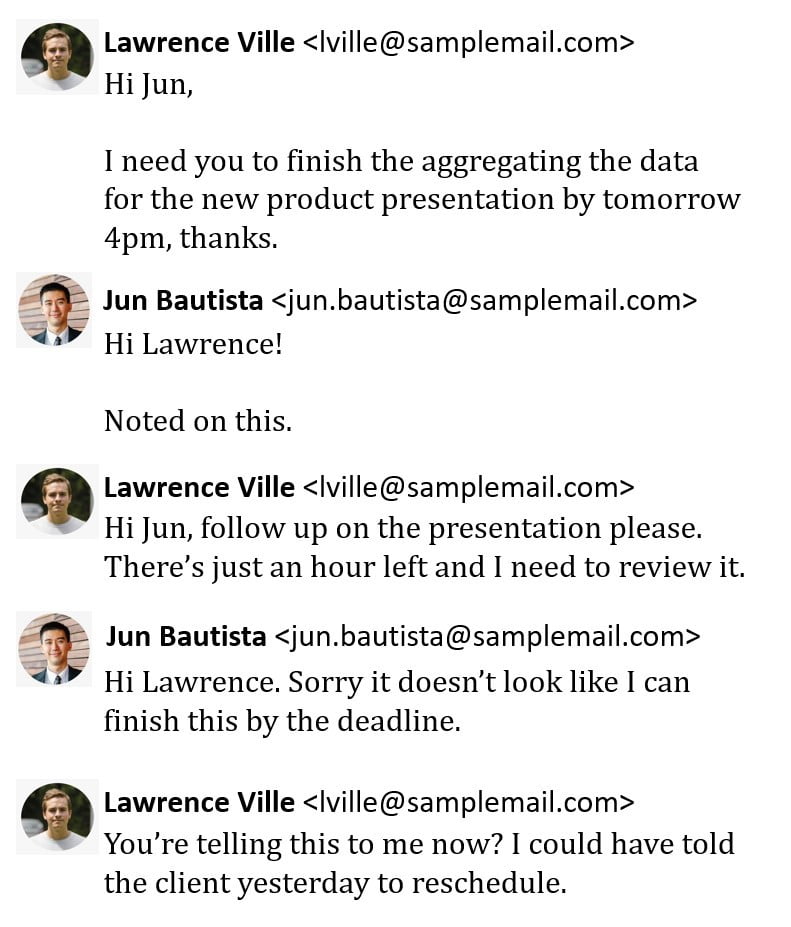
In the bad virtual communication example above, the remote worker did not voice any objections about the deadline. So, the boss also committed that deadline to their clients.
When the deadline came, there was no output to speak of. So, the project bombed and the company lost that client.
Lesson: Don’t be afraid to push back on a demand. It’s better to be open and transparent since more often than not, it leads to better working conditions and a successful work relationship.
Even if your client or employer sticks to the deadline despite you pushing back, then at least you were able to manage their expectations. They won’t be surprised if something does not go well.
Example 6: Not Taking the Time to Write a Professional Reply
Sometimes you get so busy with work that you just want to quickly reply and get back to finishing your tasks. However, you should always remember that text-based messages are prone to misunderstandings.
Take this virtual communication example below:
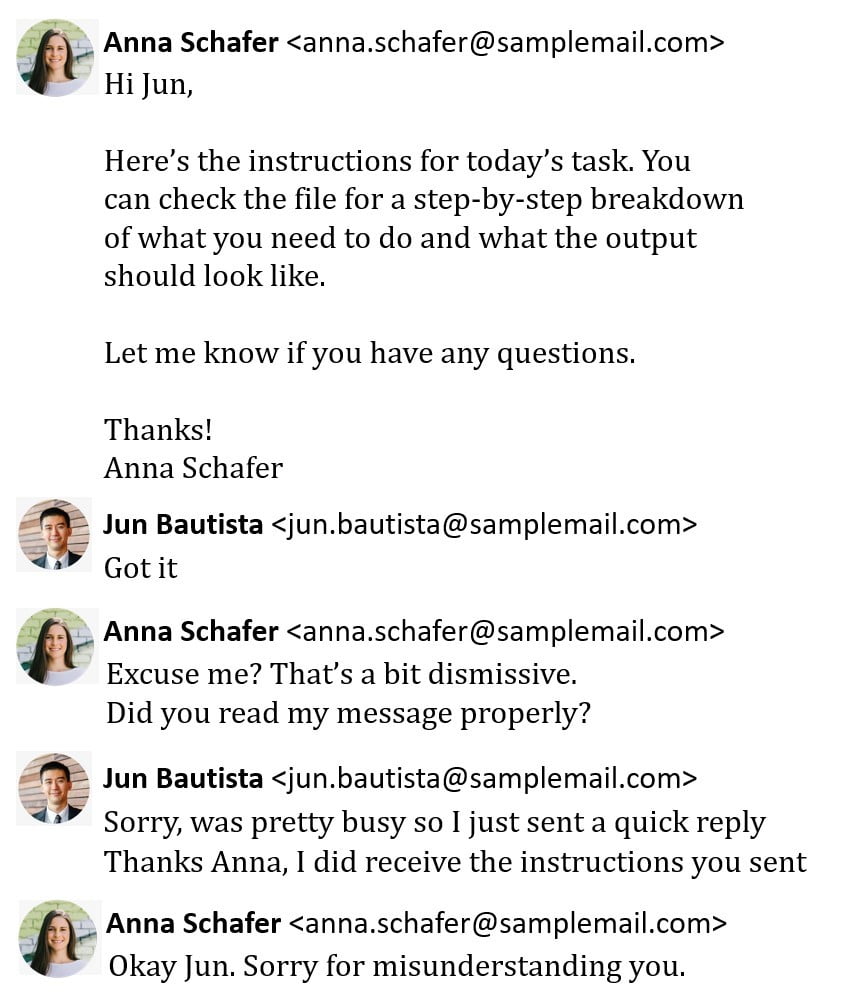
Here, the remote worker confirmed their understanding of the instructions by saying “Got it” As well-meaning as it may be, it’s unfortunate that the receiver found the message rude and dismissive. You’ll never be able to guess how some people might react even to innocent messages.
To avoid these situations, it’s always better to take a bit more time to type just a few more words. For example, by saying “Got it, Anna. Thanks for sending me the instructions” then the whole misunderstanding could have been avoided.
Lesson: When in doubt, stick to business writing. The concept of business writing is to communicate in a clear and effective manner.
Try to avoid slang, “text” speak, and short-hand to avoid any misunderstandings. Instead, try to use the receiver’s name when you communicate, and be sure to pick words and construct sentences that are easy to understand.
You can also initiate a call when clarifying things to avoid any misunderstandings done through text-based virtual communication.
Example 7: Using Words That Have Multiple Meanings
Another mistake you might make when rushing a reply is using words with multiple meanings. Without proper context, these words may lead to misunderstandings and conflicts.
Let’s look at how the word “resign” was used in this virtual communication example:
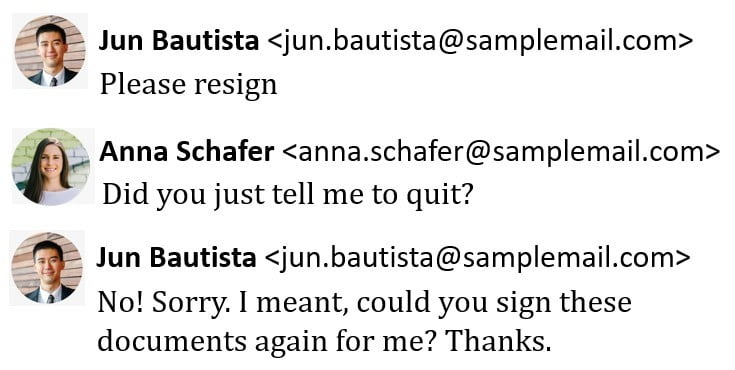
While rushing to have some documents signed again, the sender was not able to predict that the message would be misunderstood. With more context, this could have been avoided. The sender could have said “Hi Anna, please resign these documents for me. Thanks!”
Lesson: Don’t rush, add context to your messages. Meanings can be lost in translation due to the limitations of text-based communication. So, don’t rush and add a bit of context to your messages to avoid any misunderstandings.
Example 8: Not Proofreading Before Hitting Send
A lot of the previous bad virtual communication examples could have been avoided by simply doing proofreading before hitting the send button. It’s risky to make communication mistakes online especially when your livelihood is at stake.

Proofreading will also help you avoid forgetting to attach your files and sending the message to the wrong recipient. So, never forget to proofread your messages.
There are also many free and useful proofreading tools you can use. One of them is Grammarly, a free browser plug-in. This tool helps you spot spelling and grammar errors on your email and messaging apps. It was even used to correct the errors in this very article!
Conclusion: The Importance of Communication
A huge part of being a successful remote Filipino worker is learning the skills to communicate online clearly and efficiently. Being transparent and consistent in communicating with your employers and clients will help set you apart from other online workers.
When clients and employers are confident that you will communicate with them whenever necessary, the more likely that you’ll leave a favorable impression on them. This could lead to 5-star reviews, promotions, more jobs, or even a 6-figure monthly income.
Don’t underestimate what proper virtual communication can do for your online career.
Frequently Asked Questions
i) How can I improve my virtual communications skills as a remote Filipino worker?
After reading through the bad virtual communication examples from this article, you should have a better idea about what to avoid. Remember to communicate often, write your messages clearly, and don’t hesitate to ask questions.
Virtual communication skills are something that you improve on through practice. You’ll likely make some more mistakes in the future. However, what’s important is that you learn from them.
ii) What should I write in an email when sending a portfolio?
When applying for a job or messaging a client, most people make the mistake of making it about “them” and not about the “client”. You need to find out what exactly the client is looking for to understand what you should write in your email and what you should showcase in your portfolio.
You can take the same approach as you would when writing a resume for an online job. Make your message stand out from your competitors by doing enough research on your employer or client.
Don’t use the same message for every application, do your due diligence and carefully research each online job.

iii) How do I send a message on Onlinejobs.ph?
In Onlinejobs.ph, you can send a message by clicking the “Apply for this job” button on the top of the job details page. But remember to read the job’s requirements very carefully.
Getting hired is a matching game and not a lottery. You need to find out what will make your message stand out from the other people applying for the job. You can do this by going to the company’s website and social media pages.
To find out how to maximize your chances of success, please see the article “How to Get Hired on Onlinejobs.ph: Ultimate 7-Step Guide“
iv) How do I tell my boss that the power is out?
Living in the Philippines, it’s unavoidable to have power interruptions every now and then, especially during the bagyo or storm season. Just be honest with your boss or client regarding your current situation. As long as they are reasonable, they will understand that it’s out of your control.
However, you should also reassure them that you are doing what you can to produce whatever output they need on time. If it’s not possible to deliver on time, make sure to communicate it early so that they can make adjustments.
There are also tools and equipment that you can prepare to minimize how brownouts or blackouts may affect your productivity. To avoid power interruptions impacting your work, you might want to check out “How to Work from Home During Brownouts in the Philippines”.





